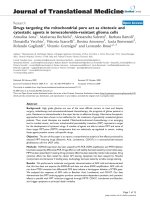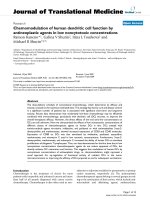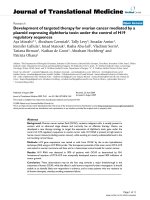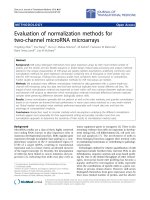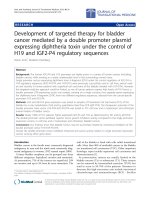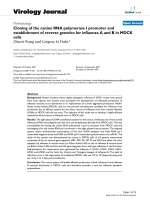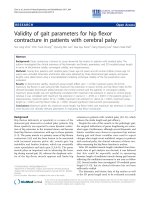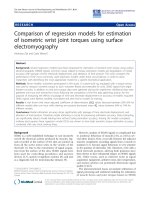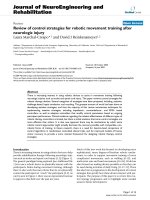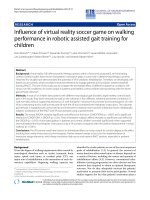Báo cáo hóa học: " Cloning of the canine RNA polymerase I promoter and establishment of reverse genetics for influenza A and B in MDCK cells" pdf
Bạn đang xem bản rút gọn của tài liệu. Xem và tải ngay bản đầy đủ của tài liệu tại đây (678.9 KB, 12 trang )
BioMed Central
Page 1 of 12
(page number not for citation purposes)
Virology Journal
Open Access
Methodology
Cloning of the canine RNA polymerase I promoter and
establishment of reverse genetics for influenza A and B in MDCK
cells
Zhaoti Wang and Gregory M Duke*
Address: MedImmune, 297 North Bernardo Avenue, Mountain View, CA 94043, USA
Email: Zhaoti Wang - ; Gregory M Duke* -
* Corresponding author
Abstract
Background: Recent incidents where highly pathogenic influenza A H5N1 viruses have spread
from avian species into humans have prompted the development of cell-based production of
influenza vaccines as an alternative to or replacement of current egg-based production. Madin-
Darby canine kidney (MDCK) cells are the primary cell-substrate candidate for influenza virus
production but an efficient system for the direct rescue of influenza virus from cloned influenza
cDNAs in MDCK cells did not exist. The objective of this study was to develop a highly efficient
method for direct rescue of influenza virus in MDCK cells.
Results: The eight-plasmid DNA transfection system for the rescue of influenza virus from cloned
influenza cDNAs was adapted such that virus can be generated directly from MDCK cells. This was
accomplished by cloning the canine RNA polymerase I (pol I) promoter from MDCK cells and
exchanging it for the human RNA pol I promoter in the eight plasmid rescue system. The adapted
system retains bi-directional transcription of the viral cDNA template into both RNA pol I
transcribed negative-sense viral RNA and RNA pol II transcribed positive-sense viral mRNA. The
utility of this system was demonstrated by rescue in MDCK cells of 6:2 genetic reassortants
composed of the six internal gene segments (PB1, PB2, PA, NP, M and NS) from either the cold-
adapted (ca) influenza A vaccine strain (ca A/Ann Arbor/1/60) or the ca influenza B vaccine strain
(ca B/Ann Arbor/1/66) and HA and NA gene segments from wild type influenza A and B strains.
Representative 6:2 reassortants were generated for influenza A (H1N1, H3N2, H5N1, H6N1,
H7N3 and H9N2) and for both the Victoria and Yamagata lineages of influenza B. The yield of
infectious virus in the supernatant of transfected MDCK cells was 10
6
to 10
7
plaque forming units
per ml by 5 to 7 days post-transfection.
Conclusion: This rescue system will enable efficient production of both influenza A and influenza
B vaccines exclusively in MDCK cells and therefore provides a tool for influenza pandemic
preparedness.
Published: 23 October 2007
Virology Journal 2007, 4:102 doi:10.1186/1743-422X-4-102
Received: 13 September 2007
Accepted: 23 October 2007
This article is available from: />© 2007 Wang and Duke; licensee BioMed Central Ltd.
This is an Open Access article distributed under the terms of the Creative Commons Attribution License ( />),
which permits unrestricted use, distribution, and reproduction in any medium, provided the original work is properly cited.
Virology Journal 2007, 4:102 />Page 2 of 12
(page number not for citation purposes)
Background
The type A and B influenza viruses have genomes consist-
ing of eight negative-sense single-stranded viral RNAs
(vRNAs), each of which contains a coding region and ter-
minal 5' and 3' noncoding regions. Within the virion, the
vRNAs are associated with nucleoprotein (NP) and the
three polymerase subunits (PB1, PB2, PA) to form ribonu-
cleoprotein (RNP) complexes. Upon infection of cells, the
RNPs are released into the cytoplasm and subsequently
enter the nucleus where replication of the vRNA results in
the production of both mRNA and complementary RNA
(cRNA), the template for synthesis of more vRNA. Errors
generated in the viral genome during replication by a low
fidelity viral RNA polymerase combined with the seg-
mented arrangement of the influenza genome has
resulted in the generation of reassortants in nature with
new genetic characteristics. Natural influenza variants
have emerged in the past for which humans have little to
no immunity and world wide influenza pandemics have
ensued.
One aspect of preparation for an influenza pandemic is to
create adequate production facilities for vaccine manufac-
ture. Although current production of influenza vaccines
for human vaccination is in most cases an egg-base proc-
ess, many vaccine manufacturers are actively developing
cell-based influenza vaccine capabilities. Cell-based influ-
enza vaccine production is potentially less susceptible to
biological contamination and more adaptable to large
scale production than current egg-based vaccine produc-
tion. The ability to quickly increase the scale of influenza
vaccine production is especially critical in response to an
incipient pandemic influenza outbreak, where global vac-
cination could be an important defence against the devel-
opment of a full blown pandemic. To this end, MDCK
cells are being developed by many of the influenza vac-
cine manufacturers as a cell-substrate for influenza vac-
cine production because of the capacity for high virus
yields of both A and B strains in this cell line.
In addition to the cell substrate used for influenza virus
production, response time to pandemic influenza may be
impacted by the need to generate a pandemic vaccine
from properly constructed influenza reassortants. These
may be reassortants with high growth properties for inac-
tivated vaccine production or reassortants which carry
influenza segments that confer attenuation to the result-
ing pandemic vaccine, either to function as a live vaccine
or to reduce risk to production personnel when producing
an inactivated vaccine. For any desired reassortant, influ-
enza reverse genetics systems based on rescue of virus
from transfected plasmids encoding the viral genome
increases the quality, speed, accuracy and reliability of
obtaining a desired reassortant as compared to classical
reassortment techniques based on dual strain infections
followed by selection. Currently, Vero cells are the only
cell substrate licensed for plasmid-based rescue of human
vaccines. Yet, efficient rescue in Vero cells is hampered by
their low productivity for many influenza strains. This
prompted us to develop an efficient influenza plasmid-
based rescue system in MDCK cells. Although direct influ-
enza A rescue in MDCK cells from a plasmid system based
on a T7 RNA polymerase vector has been reported, this
system has not been documented to work for type B influ-
enza strains and is less efficient than the eight plasmid
bidirectional system which utilizes cellular RNA polymer-
ase I (pol I) and RNA pol II (pol II) to synthesize vRNA
and viral mRNA, respectively, from plasmids transfected
into susceptible cells [1]. Although efficient rescue occurs
in the bidirectional system, the species specificity of the
RNA pol I promoter limits its utility to cells from species
within the same taxonomic order [2]. The result, which we
have confirmed, is that the bidirectional human RNA pol
I based plasmid rescue system which functions in primate
cells such as Vero, does not support influenza rescue in
MDCK cells (data not shown).
For these reasons, we chose to develop a bidirectional
influenza reverse genetics system which utilizes a canine
RNA pol I promoter derived from MDCK cells as a refine-
ment of the human RNA pol I system developed by Hoff-
mann and co-workers [3].
Results and discussion
Cloning the canine RNA polymerase I promoter from
MDCK DNA
In higher eukaryotes, ribosomal RNA (rRNA) genes are
transcribed by RNA pol I into a large 45S pre-rRNA which
is subsequently processed into mature 18S, 5.8S and 28S
rRNAs. Although the mature rRNA sequences are con-
served among higher eukaryotes, the 5' non-transcribed
region directly upstream of the transcription start site,
which contains the RNA pol I promoter and other regula-
tory sequence elements, has diverged significantly and is
conserved only among species within the same taxonomic
order [2,4]. Functionally this results in the RNA pol I pro-
moter from a species of one order not being recognized by
the RNA pol I and transcription factors from species
belonging to other orders. The currently described pol I
promoters used in the rescue of recombinant influenza
will function only in primate or avian cells [5-7]. In order
to rescue influenza using the RNA pol I transcription
machinery in canine cells, cloning the canine RNA pol I
promoter was necessary.
In developing an approach to cloning the canine RNA pol
I promoter, we examined the known features of the RNA
pol I promoters and rRNA genes from other mammalian
species. In the genomes of human, mouse and rat, the dis-
tance from the beginning of the 18S rRNA sequences to
Virology Journal 2007, 4:102 />Page 3 of 12
(page number not for citation purposes)
the RNA pol I transcription initiation site is 3676, 4026
and 4264 bp, respectively. A BLAST analysis of the pre-
rRNA sequences upstream of the 18S rRNA of these spe-
cies revealed no significant similarities among the
sequences (data not shown). Functional assays using
cloned regions of DNA have demonstrated that the region
immediately upstream of a transcription initiation site has
RNA pol I promoter activity in vitro and the sizes of these
cloned promoter elements have been narrowed to 225 bp
and 169 bp for human and mouse genomes, respectively
[5,8]. Based on these data, we hypothesized that a func-
tional RNA pol I promoter may be present within a region
from 3000 to 5000 bp upstream of the beginning of the
canine 18S rRNA gene. Thus, our strategy for isolating the
canine RNA pol I promoter was to clone a MDCK genomic
DNA fragment that contained sequences which extended
at least 5 kb upstream from the start of the 18S rRNA gene
sequence. The resulting MDCK clone then would be tested
for RNA pol I promoter activity in vitro.
The sequence of the region upstream of the canine 18S
rRNA initiation site was identified by querying the canis
familiaris genome with the published canine 18S rRNA
sequence [GenBank:AY262732
, GenBank:NW_878945].
As expected, analysis of the 5 kb region upstream of the
canine 18S rRNA gene showed no significant similarity to
human or mouse sequences, nevertheless we suspected
that this region contained the canine RNA pol I promoter
and transcription initiation site. The predicted restriction
sites in the sequence of the canis familiaris genome [Gen-
Bank:NW_878945
], which was derived from a boxer, were
used to guide the digestion of MDCK (cocker spaniel)
genomic DNA in order to determine the extent of restric-
tion site conservation and to identify restriction fragments
expected to contain the RNA pol I promoter (Fig. 1A).
These restriction fragments were then probed with18S
rRNA sequences in Southern hybridizations (Fig. 1B).
Although some of the restriction fragments are conserved
in both MDCK and canis familiaris DNA (AvrII, BamHI,
EcoRI, HindIII and SacI), the Southern results indicated
that there was some divergence between these sequences
as evinced by the SpeI, SphI and XbaI digestions, since the
predominate fragments hybridizing to the 18S rRNA
probe in these digests were not predicted by the canis
familiaris sequence (Fig. 1C).
Based on the restriction map constructed from the sites
conserved between MDCK DNA and the canis familiaris
genome, the 7.1 kb EcoRI fragment which hybridized to
the 18S rRNA probe was chosen as a potential RNA pol I
promoter candidate since it should be large enough to
encompass the pol I promoter based on the relationship
between the human pol I promoter, the transcription ini-
tiation site and start of the 18S rRNA gene sequence.
MDCK DNA was digested with EcoRI, subjected to agarose
gel electrophoresis and DNA approximately 7 kb in size
recovered from the gel. This DNA was ligated into EcoRI
digested pGEM7 followed by transformation of TOP 10 E.
coli. DNA preparations from the resulting ampicillin
resistant colonies were used as templates in PCR reactions
containing forward and reverse primers to the canine 18S
rRNA gene. One PCR positive clone (pK9PolI) was identi-
fied which upon subsequent sequence analysis confirmed
that it contained 18S rRNA sequences and extended
approximately 5.5 kb upstream of the 18S rRNA
sequences. A 3.5 kbp EcoRI-BamHI fragment was sub-
cloned to generate pK9Pol I EB and sequenced. The result-
ing MDCK sequence was aligned to the canis familiaris
genomic sequences and they were determined to have
96% identity (Fig. 2).
In order to evaluate the presence of pol I promoter activity
in cloned DNA fragments, an MDCK-based assay for rep-
lication of an artificial influenza vRNA containing a
reporter gene was developed based on an analogous assay
used to evaluate the human RNA pol I promoter [9]. The
DNA sequences to be tested for RNA pol I activity are
cloned upstream of a negative sense reporter gene which
has 5' and 3' terminal noncoding sequences derived from
influenza vRNA. These noncoding regions of the vRNA in
turn enable the antisense reporter transcript to be recog-
nized by influenza replication proteins expressed by co-
transfected plasmids and converted into a positive sense
transcript which is subsequently translated into a reporter
protein, such as enhanced green fluorescence protein
(EGFP) or chloramphenicol acetyltransferase (CAT).
Additionally, due to the nature of the influenza replica-
tion machinery, the transcription initiation and termina-
tion sites of this vRNA reporter are critical for
functionality, addition of even one extra nucleotide at the
5' end of the negative sense vRNA abrogates the function
of this molecule. Therefore, if no pol I promoter element
is present in the cloned DNA fragment or if the transcrip-
tion initiation site is not accurate, no vRNA will result and
no reporter signal will be measured.
In order to determine the position of the rRNA transcrip-
tion initiation site,
32
P labeled primers predicted to be
<500 bases from the transcription initiation site were used
to prime cDNA synthesis on MDCK whole cell RNA. The
sizes of the cDNA products from two different primers
(PrimEx1 and PrimEx2, Fig. 2) were determined to be
approximately 370 and 220 bases, respectively (Fig. 3A).
The size of the smaller cDNA product was more accurately
determined to be 216 bases by electrophoresis of the
cDNA product adjacent to sequencing reactions of
M13mp18 DNA, which served as a size ladder (Fig. 3B).
In other primer extension reactions, an additional 218
base product also was observed (data not shown).
Virology Journal 2007, 4:102 />Page 4 of 12
(page number not for citation purposes)
The transcription initiation site was predicted to be either
C or T in the sequence shown in Fig. 3C by counting 216
or 218 bases upstream of PrimerEx2 in the MDCK
sequence. Yet, when the sequences encompassing this
region were aligned to the sequences adjacent to known
RNA pol I transcription initiation site sequences of other
species, conserved residues in the alignment suggested
that the G residue shown in Fig. 4 (arrow) would be tran-
scription initiation site. To address the inconsistency in
the primer extension data and the alignments, the MDCK
sequences from pK9Pol I EB upstream of the T, G or C res-
idues were individually subcloned into artificial vRNA-
EGFP reporter plasmids (Fig. 5A,B). The resulting test
reporter constructs are composed of an EGFP gene flanked
first by the noncoding regions from an influenza M-seg-
ment and then by a murine RNA pol I terminator
sequence and the MDCK test sequences. Examination, by
fluorescence microscopy, of MDCK cells co-electropo-
rated with expression plasmids for the four influenza rep-
lication proteins PB1, PB2, PA and NP plus a single
MDCK RNA pol I EGFP reporter construct indicated that
use of the MDCK sequences upstream of the G residue in
the reporter construct resulted in a RNA pol I synthesized
negative sense EGFP transcript which could be replicated
Restriction enzyme analysis of canis familiaris and MDCK DNAsFigure 1
Restriction enzyme analysis of canis familiaris and MDCK DNAs. (A) Restriction map of the canis familiaris genomic
sequence [GenBank:NW_878945
] which encompasses the 18S r RNA gene. The arrow indicates the position of the MDCK
7.1 kb EcoR I fragment which hybridized to the 18S rRNA gene probe. (B) Southern hybridization of MDCK DNA. Left panel:
Single restriction enzyme digestions of MDCK DNA were subjected to electrophoresis on a 0.7% agarose gel and detected by
ethidium bromide staining. M: 1 kb ladder (Invitrogen); Lanes 1–8: Avr II, BamH I, EcoR I, Hind III, Sac I, Spe I, Sph I, Xba I; C:
18S rRNA gene probe. Right panel: Southern blot of gel in left panel after hybridization to a psoralen-biotin labeled 18S rRNA
gene probe (0.5 kb) and detection by chemilumiscense. The 7.1 kb EcoR I fragment (arrow) was cloned and analyzed for RNA
pol I promoter activity. (C) Comparison of the size of selected restriction fragments predicted by the canis familiaris genomic
sequence to hybridize to the 18S rRNA gene probe and those restriction fragments from MDCK DNA which were observed
to hybridize.
MDCK Eco RI 7.1 kb Fragment
Probe
HindIII
XbaI
BamHI
BamHI
BamHI
AvrII
SpeI EcoRI
BamHI
SacI
BamHI
BamHI
XbaI
XbaI
BamHI
SphI
SpeI
EcoRI
HindIII
XbaI
BamHI
SacI
BamHI BamHI AvrII
A
B
C
M 1 2 3 4 5 6 7 8 C M 1 2 3 4 5 6 7 8 C
9.0, 10.0, 11.0
*
4.0
1.0
1.6
2.0
3.0
0.5
5.0
6.0
7.0
8.0
*
18S rRNA Gene
Virology Journal 2007, 4:102 />Page 5 of 12
(page number not for citation purposes)
to higher levels by the influenza replication proteins, as
judged by higher EGFP fluorescent intensity (Fig. 5C) and
greater number of fluorescent cells (data not shown). In
assays which utilized reporter constructs with the MDCK
sequences upstream of the T or C residues, the influenza
replication proteins still recognized and replicated the
RNA pol I synthesized EGFP transcript, although to lower
levels than that observed with the MDCK sequences
upstream of the G residue (Fig. 5C). Since authentic influ-
enza sequences without any extra nucleotides are required
at the termini of a RNA transcript for it to be replicated
efficiently by the influenza replication complex, the
results taken as a whole indicate that MDCK RNA pol I
predominantly initiates transcription at the G residue in
Fig. 4 (arrow) but to a lesser extent utilizes the adjacent T
and C residues.
The EGFP reporter assay established that a functional
MDCK RNA pol I promoter was contained in the 1803 bp
sequence upstream of the initiation site. But this sequence
is much larger than that required in human and mouse for
RNA pol I activity, where the 225 bp (human) or 169 bp
(mouse) sequence immediately upstream of the transcrip-
tion initiation site has pol I promoter activity when trans-
ferred into expression constructs [5,8]. To determine if a
similar situation held for the MDCK RNA pol I promoter,
MDCK DNA fragments which contained sequences that
extended various distances upstream of the transcription
initiation site were cloned into an artificial vRNA contruct
where the EGFP gene had been replaced by a CAT gene. A
CAT based system was chosen because CAT expression
was found to be capable of detecting differences in RNA
pol I activity more accurately than EGFP fluorescence
(data not shown). As shown in Fig. 6, the highest level of
CAT expression was observed with the construct contain-
ing the 469 bp sequence upstream of the transcription ini-
tiation site. Reduction to 230 bp and 88 bp upstream of
the transcription site lowered CAT expression approxi-
mately 35% and 85%, respectively. Finally, the construct
with 77 bp upstream of the transcription start site had
basal levels of CAT expression similar to the human RNA
pol I artificial vRNA construct, pHW72-CAT, which does
not contain any MDCK sequences.
Based on these results, a MDCK pol I promoter/CMV pol
II promoter bidirectional transcription vector was derived
from the analogous human RNA pol I promoter/CMV pol
II promoter construct, pAD3000, by substitution of the
MDCK 469 bp sequence upstream of the transcription site
for the human RNA pol I promoter sequence in pAD3000
[3,10]. The resulting construct was designated pAD4000
(Fig. 7). In addition, the two BsmBI restriction sites in
Alignment of canis familiaris sequence and sequences of the MDCK EcoRI-BamHI fragment in pK9Pol I EBFigure 2
Alignment of canis familiaris sequence and sequences of the MDCK EcoRI-BamHI fragment in pK9Pol I EB. The
positions of the primers (PrimEx 1 and PrimEx 2) used in primer extension reactions on MDCK whole cell RNA are indicated
by arrows.
1467 15941480 1490 1500 1510 1520 1530 1540 1550 1560 1570 1580
(1467)
GGACGGCCTCCGCACGGTGCCTGCCTCCGGAGAACTTTGATGATTTTTCAAAGTCTCCTCCCGGAGATCACTGGC GTGGCGGCGTGGCGGCGTGGCGGCGTGGCGGCGTGGC
canus fam EcoRI BamHI (1441)
GGACGGC-TCCGCACGGTGCCTGC-TCCGGAGAACTTTGATGATTTTTCAAAGTC CTCCCGGAGATCACTGGCTTGGCGGCGTGGCGGCGTGGCGGCGTGGCGGCGTGGCGGCGTGGCGGCGTGGC
pK9 Pol I EB (1444)
GGACGGC TCCGCACGGTGCCTGC TCCGGAGAACTTTGATGATTTTTCAAAGTC CTCCCGGAGATCACTGGC GTGGCGGCGTGGCGGCGTGGCGGCGTGGCGGCGTGGC
Consensus (1467)
1595 17221600 1610 1620 1630 1640 1650 1660 1670 1680 1690 1700 1710
(1595)
GTCTCCACCGACCGCGTATCGCCCCTCCTCACC CCCCCCCCCCCCCGGGTTACCTGGGGCGACCAGAAAGCCCTGGGGGCNGGGGGCTCCGTGGGGTGGGGGTGGGGGGGCGCCGTGGGGCAGGTTTT
canus fam EcoRI BamHI (1553)
GTCTCCACCGACCG-GTATCGCCCCTCCTCCCC TCCCCCCCCCCCCCCGTTCCCTGGGTCGACCAGATAGCCCTG GGGGCTCCGTGGGGTGGGGGTGGGGGGGCGCCGTGGGGCAGGTTTT
pK9 Pol I EB (1568)
GTCTCCACCGACCG GTATCGCCCCTCCTC CC CCCCCCCCCCCC GTT CCTGGG CGACCAGA AGCCCTG GGGGCTCCGTGGGGTGGGGGTGGGGGGGCGCCGTGGGGCAGGTTTT
Consensus (1595)
1723 18501730 1740 1750 1760 1770 1780 1790 1800 1810 1820 1830
(1723)
GGGTACAGTTGGCCGTGTCACGGTCCCGGGAGGTCGCGGTGACCTGTGGCTGGTCCCCGCCGGCAGGCGCGGTTATTTTCTTGCCCGAAATGAACATTTTTTGTTGCCAGGTAGGTGCTGACACGTTG
canus fam EcoRI BamHI (1681)
GGGGACAGTTGGCCGTGTCACGGTCCCGGGAGGTCGCGGTGACCTGTGGCTGGTCCCCGCCGGCAGGCGCGGTTATTTTCTTGCCCGAGATGAACATTTTTTGTTGCCAGGTAGGTGCTGACACGTTG
pK9 Pol I EB (1688)
GGG ACAGTTGGCCGTGTCACGGTCCCGGGAGGTCGCGGTGACCTGTGGCTGGTCCCCGCCGGCAGGCGCGGTTATTTTCTTGCCCGA ATGAACATTTTTTGTTGCCAGGTAGGTGCTGACACGTTG
Consensus (1723)
1851 19781860 1870 1880 1890 1900 1910 1920 1930 1940 1950 1960
(1851)
TGTTTCGGCGACAGGCAGACAGACGACAGGCAGACGTAAAAGACAGCCGGTCCGTCCGTCGCTCGCCTTAGAGATGTGGGCCTCTGGGCGCGGGTGGGGTTCCGGGCTTGACCGCGCGGCCGAGCCGG
canus fam EcoRI BamHI (1809)
TGTTTCGGCGACAGGCAGACAGACGACAGGCAGACGTAAAAGACAGCCGGTCCGTCCGTCGCTCGCCTTAGAGATGTGGGCCTCTGGGCGCGGGTGGGGTTCCGGGCTTGACCGCGCGGCCGAGCCGG
pK9 Pol I EB (1816)
TGTTTCGGCGACAGGCAGACAGACGACAGGCAGACGTAAAAGACAGCCGGTCCGTCCGTCGCTCGCCTTAGAGATGTGGGCCTCTGGGCGCGGGTGGGGTTCCGGGCTTGACCGCGCGGCCGAGCCGG
Consensus (1851)
1979 21061990 2000 2010 2020 2030 2040 2050 2060 2070 2080 2090
(1979)
TCCCTGTCCTCGCTCGCTGGAGCCTGAGCCGTCCGCCTGGGCCTGCGCGCCGGCTCTCGTGCTGGACTCCAGGTGGCCCGGGTCGCGGTGTCGCCCTCCGGTCTCCGGCACCCGAGGGAGGGCGGTGT
canus fam EcoRI BamHI (1937)
TCCCTGTCCTCGCTCGCTGGAGCCTGAGCCGTCCGCCTGGGCCTGCGCGCCGGCTCTCGTGCTGGACTCCAGGTGGCCCGGGTCGCGGTGTCGCCCTCCGGTCTCCGGCACCCGAGGGAGGGCGGTGT
pK9 Pol I EB (1944)
TCCCTGTCCTCGCTCGCTGGAGCCTGAGCCGTCCGCCTGGGCCTGCGCGCCGGCTCTCGTGCTGGACTCCAGGTGGCCCGGGTCGCGGTGTCGCCCTCCGGTCTCCGGCACCCGAGGGAGGGCGGTGT
Consensus (1979)
2107 22342120 2130 2140 2150 2160 2170 2180 2190 2200 2210 2220
(2107)
GGGCAGGTGGCGGTGGGTCTTTTACCCCCGTGCGCTCCATGCCGTGGGCACCCGGCCGTTGGCCGTGACAACCCCTGTCTCGCAAGGCTCCGTGCCGCGTGTCAGGCGTCCCCCGCTGTGTCTGGGGT
canus fam EcoRI BamHI (2065)
GGGCAGGTGGCGGTGGGTCTTTTACCCCCGTGCGCTCCATGCCGTGGGCACCCGGCCGTTGGCCGTGACAACCCCTGTCTCGCAAGGCTCCGTGCCGCGTGTCAGGCGTCCCCCGCTGTGTCTGGGGT
pK9 Pol I EB (2072)
GGGCAGGTGGCGGTGGGTCTTTTACCCCCGTGCGCTCCATGCCGTGGGCACCCGGCCGTTGGCCGTGACAACCCCTGTCTCGCAAGGCTCCGTGCCGCGTGTCAGGCGTCCCCCGCTGTGTCTGGGGT
Consensus (2107)
PrimEx 1
PrimEx 2
Virology Journal 2007, 4:102 />Page 6 of 12
(page number not for citation purposes)
pAD3000 which are used for cloning sequences between
the two promoters were changed to BbsI sites because the
former restriction site occurs in the MDCK RNA pol I pro-
moter containing fragment. Like pAD3000, in pAD4000
there is bi-directional transcription of influenza genomic
segments inserted between the two BbsI sites, with the pol
I promoter driving expression of influenza vRNA
sequences and the CMV pol II promoter directing synthe-
sis of viral mRNA.
Generation of FluMist
®
strains from eight plasmids
FluMist is a licensed live attenuated influenza vaccine
which currently contains two A virus strains (H1N1 and
H3N2) and one influenza B strain. Each vaccine strain
component of FluMist is a 6:2 reassortant, composed of
the six internal gene segments (PB1, PB2, PA, NP, M, and
NS) from an attenuated master donor virus (MDV) strain
and the HA and NA gene segments from a wild type (wt)
strain. The FluMist MDV strains are ca A/Ann Arbor/6/60
and ca B/Ann Arbor/1/66, originally developed by serial
passage at successively reduced temperatures in primary
chick kidney cells [11,12].
To demonstrate MDCK RNA pol I plasmid-based rescue,
the eight genomic segments of cold adapted (ca) A/Ann
Arbor/6/1960 (MDV-A) and ca B/Ann Arbor/1/1966
(MDV-B) were cloned into pAD4000. Mixtures of eight
plasmids (3 μg each) which encoded either the genome of
MDV-A or MDV-B were electroporated into MDCK cells.
Samples of the media supernatants from the electropo-
rated cells were collected on day 2 – 7 post- electropora-
tion and used in plaque assays to determine virus titer. As
shown in Table 1, maximum amounts of virus accumu-
lated in the media on day 4 (1.3 × 10
8
pfu/ml MDV-A and
2.3 × 10
7
pfu/ml MDV-B).
As a control to demonstrate the rescued virus was derived
from the genomic sequences carried in the plasmids,
MDV-B NS and PB1 genes containing the silent coding
mutations NS (416 A/G) and PB1 (561 T/C, 924 A/G)
were also inserted into pAD4000 and substituted for their
MDV-B counterparts in an eight plasmid MDV-B mix.
Electroporation of MDCK cells with this mix resulted in
Comparison of sequences flanking RNA pol I promoter tran-scription initiation sitesFigure 4
Comparison of sequences flanking RNA pol I pro-
moter transcription initiation sites. Sequences adjacent
to known RNA pol I promoter transcription initiation sites
(nt -20 to + 10) from the indicated species were aligned with
MDCK sequences flanking the transcription initiation site
mapped by primer extension. The first base of the predomi-
nate RNA transcript of the indicated species is labeled +1.
Conserved residues are indicated blue, red and green letter-
ing. For all the indicated species, the -1 position is a T (red)
and the +1 position a purine residue (green). The sequences
from +2 to +9 (blue) are conserved in the indicated mamma-
lian species. Based on the aligned sequences, the G residue
(arrow) in the MDCK sequences was predicted to be the
RNA pol I promoter transcription initiation site.
-20 -9 +1 +10
GCGGGTTCAAAAACTACTATAGGTAGGCAG Drosophila
TGCCTTATATGTTCGTCTGTAGGAGCGAGT Chicken
GCATGTGCGGGCAGGAAGGTAGGGGAAGAC Xenopus
TATTGTACCTGGAGATATATGCTGACACGC Rat
TATTGGACCTGGAGATAGGTACTGACACGC Mouse
TTTGGGCCGCCGGGTTATATGCTGACACGC Human
TTTTTTGTTGCCAGGTAGGT
G
CTGACACGT MDCK
Determination of the MDCK RNA pol I promoter transcrip-tion initiation site by primer extension analysisFigure 3
Determination of the MDCK RNA pol I promoter
transcription initiation site by primer extension anal-
ysis. (A) Primer extension reactions on MDCK whole cell
RNA using the
32
P labeled primers PrimEx1 and PrimEx2.
Primer extension products and
32
P ΦX174 size marker
DNAs (lane M) were subjected to electrophoresis on a 6%
polyacrylamide, 7 M urea gel followed by detection of the
radioisotope in the gel with a BioRad Molecular Imager Fx.
The maximum length of the observed products were approx-
imately 370 bases and 220 bases, respectively, for the reac-
tions using PrimEx1 (lane 1) and PrimEx2 (lane 2). (B) The
products from the PrimEx2 reaction were subjected to elec-
trophoresis adjacent to a M13 sequencing ladder on a 6%
polyacrylamide, 7 M urea sequencing gel in order to more
accurately determine the maximum length of the products
synthesized. (C) The MDCK DNA sequences adjacent to the
positions where the largest PrimEx2 products terminated.
G A T C
M
13
m
p
1
8
seq
u
e
n
c
e
P
r
i
m
E
x
2
r
e
a
c
t
i
o
n
216 bases
B
427, 417, 413
726,713
553, 500
311
249
200
M12
A
C
TTTTTTGTTGCCAGGTAGG
T
G
C
TGACAG
2
1
6
b
a
s
e
s
2
1
8
b
a
s
e
s
Virology Journal 2007, 4:102 />Page 7 of 12
(page number not for citation purposes)
an accumulation of supernatant virus with kinetics and
titer similar to that of the nonmutated MDV-B rescue
(Table 1). Subsequent sequence analysis of supernatant
virus from the MDV-B NS/PB1 mutant electroporation
confirmed the presence of the mutations in the rescued
virus and demonstrated that this virus was plasmid
derived.
To demonstrate that the MDCK RNA pol I based rescue
system was applicable to a wide variety of seasonal Flu-
Mist vaccine strains, the HA and NA segments from type A
subtypes H1N1and H3N2 plus additional B isolates rep-
resenting both the Victoria and Yamagata lineages were
cloned into pAD4000 and used to rescue 6:2 reassortants
in MDCK cells As shown in Table 2, virus titers of approx-
Replication of artificial vRNA-EGFP reporter transcripts in MDCK cellsFigure 5
Replication of artificial vRNA-EGFP reporter transcripts in MDCK cells. (A) Schematic representation of the MDCK
EcoR I- BamH I fragment in pK9Pol I EB. The G residue at position 1804 in the insert was predicted from the alignment in Fig.
4 to be the transcription initiation site (TIS). Products from primer extension reactions designed to map the TIS terminated at
T (1803) and C (1805). (B) The EGFP reporter plasmids pK9GFP 1–1802(T), pK9GFP 1–1803(G) and pK9GFP 1–1804(C)
were constructed by replacing the human pol I promoter sequences in pHW72-EGFP [9] with bases 1–1802, 1–1803, and 1–
1804, respectively, from the MDCK EcoR I-BamH I insert in pK9Pol I EB. In each reporter construct, EGFP coding sequences
are flanked by the noncoding region from an influenza M segment and this transcription unit is between a murine RNA pol I
terminator (tI) and the indicated sequences from the MDCK EcoR I-BamH I insert. (C) Replication of artificial vRNA-EGFP
reporter transcripts in MDCK cells. DNA mixes composed of expression plasmids for PB1, PB2, PA and NP proteins plus a
single EGFP reporter plasmid or pΔHW72-EGFP were combined with MDCK cells and subjected to electroporation. At 48 hrs
after electroporation, GFP expression was detected by fluorescence microscopy. The plasmid pΔHW72-EGFP is a derivative of
pHW72-EGFP in which the human pol I promoter has been deleted. The MDCK cells in the panel labeled pCMV EGFP were
subjected to electroporation with pCMV EGFP plasmid alone and served a positive control.
A
B
promoter
EcoR I
BamH I
TIS(+1)
T 1803
G 1804
C 1805
pK9Pol I EB
C
t
I
pK9GFP 1-1802(T)
pK9GFP 1-1803(G)
pK9GFP 1-1804(C)
EGFP-vRNA
Sac II
Xho I
EGFP
Noncoding region of the M-segment
pK9GFP 1-1802(T) pK9GFP 1-1803(G)
pK9GFP 1-1803(G)
pK9GFP 1-1804(C)
p
Δ
ΔΔ
Δ
HW72-EGFP pCMV EGFP
Virology Journal 2007, 4:102 />Page 8 of 12
(page number not for citation purposes)
imately 10
6
to 10
7
were reached by days 5 to 7 post-trans-
fection, which is comparable to results obtained with
plasmid-based rescue using the human RNA pol I pro-
moter and a co-culture of primate and MDCK cells [3]. To
demonstrate the applicability of this system to influenza
isolates which may be precursors of pandemic strains, 6:2
reassortants were rescued in which the HA and NA were
derived from highly pathogenic wt viruses first isolated
from human cases of H5N1 infection in 1997, 2003, and
2004 (Table 2) [13]. For the three ca H5N1 reassortants,
the cleavage site of the HA gene had been modified by
removal of the highly cleavable multibasic amino acid res-
idues, which are a virulence motif in highly pathogenic
avian influenza viruses of the H5 and H7 subtypes [14]. In
addition, the ca H5N1 viruses rescued in this report were
previously rescued in Vero cells using human RNA pol I
based vectors under enhanced BL-3 containment proce-
dures and subsequently reduced to BL-2 containment sta-
tus after having been shown to be attenuated in mice,
ferrets and chicken. Also, these ca H5N1 viruses have been
shown to be protective against wt H5N1 challenge in mice
and ferrets [13]. As such, they are potential candidate vac-
cines for H5N1 infection and are under further investiga-
tion to determine whether they are appropriate for human
use.
To further test the MDCK based system, 6:2 reassortants
were rescued in which the HA and NA were derived from
isolates of the H6N1, H7N3 and H9N2 subtypes (Table
2). The wt virus which was the source of the HA and NA
for the H6N1 reassortant was isolated from teal and con-
tains seven segments (NA, PB1, PB2, PA, NP, NS and M)
which are very similar to their counterparts in the human
H5N1 virus A/Hong Kong/156/97 and it may represent a
derivative or precursor of the H5N1 viruses [15]. The
H7N3 wt virus (A/CK/BC-CN/2004) exhibits low patho-
genicity in avian species although it was isolated during
an outbreak of a related highly pathogenic H7N3 strain
which contained a multibasic amino acid insertion near
the HA0 cleavage site [16]. Finally, the H9N2 virus (A/
chicken/HK/G9/1997) is representative of one of the
three H9N2 subgroups which were isolated from poultry
in Hong Kong during the 1997 H5N1 outbreak in
humans [17].
Conclusion
Using the MDCK RNA pol I plasmid-based system, we
have demonstrated the rescue of a wide variety of influ-
enza A subtypes as well both lineages of influenza B.
These results indicate that influenza reverse genetic per-
formed exclusively in MDCK cells can efficiently result in
the rescue of seasonal FluMist vaccine strains as well as
Map of pAD4000Figure 7
Map of pAD4000. The MDCK RNA pol I/CMV pol II bidi-
rectional vector, pAD4000, was derived from pAD3000 [3],
the human pol I/CMV pol II bidirectional vector, by replace-
ment of the human pol I promoter sequence in pAD3000
with the MDCK 469 bp sequence upstream of the transcrip-
tion initiation site. In addition, the two BsmBI restriction sites
in pAD3000, which are used for cloning sequences between
the two promoters, were changed to BbsI sites because the
former restriction site occurs in the MDCK pol I containing
fragment.
pAD4000
(3100 bp)
bla
a
II
SV40
p
I
Canine
p
II
CMV
ori
t
I
CGACCT CCGAAGTT GGGGGGGAG AGT CTT CT CGA GT AGAAG ACC GA CCT ACCT GGCAACAAAAAAT GT
GCTGGAGGCTT CAACC CCC CCTCT CAGAAGAGCT CAT CT TC TGGCT GGATGGACCGTTGTTTTTTACA
t
I
BbsI XhoI BbsI
p
I
Evaluation of MDCK sequences required for RNA pol I pro-moter activityFigure 6
Evaluation of MDCK sequences required for RNA pol
I promoter activity. As indicated, various lengths of
MDCK sequences upstream of the RNA pol I promoter tran-
scription initiation site were cloned into an artificial vRNA-
CAT reporter construct. These constructs were individually
combined with expression plasmids for PB1, PB2, PA and NP
proteins and transfected into MDCK cells. At 44 hrs after
transfection, cell lysates were analyzed for CAT expression
by a colorimetric ELISA assay. In the plasmid pHW72-CAT,
the human RNA pol I promoter directs transcription of a
negative sense CAT gene.
0
10
20
30
40
50
60
70
80
90
1803 469 230 88 77
Size of MDCK sequences upstream of transcription initiation site (bp)
CAT (ng/well)
0
(pHW72-CAT)
Virology Journal 2007, 4:102 />Page 9 of 12
(page number not for citation purposes)
prototype attenuated vaccines for wt strains which may
harbor the potential for becoming pandemic. The applica-
tion of the rescue system utilizing the MDCK RNA pol I
promoter reported here is focused on the rescue of FluMist
influenza vaccine strains in MDCK cells, although our
expectation is that it should be applicable to other influ-
enza strains too. As such, this refinement of the plasmid-
based rescue system for influenza virus may be a useful
tool in the development of vaccines as a response to an
imminent pandemic.
Methods
Nucleic acid extraction and Southern hybridization
Total DNA and RNA was recovered from MDCK cells (pas-
sage 64, ATCC) using MasterPure™ DNA Purification Kit
and MasterPure™ RNA Purification Kit, respectively,
according to the manufacturer's instructions (Epicentre
Biotechnologies). For Southern hybridization experi-
ments, MDCK DNA (20 μg) was digested overnight at
37°C with the indicated restriction enzyme and subjected
to electrophoresis on 0.7 % agarose gels. DNA was trans-
ferred to Hybond-N+ membranes (Amersham Corp.) and
immobilized with a UV Crosslinker 10000 (Hoeffer Scien-
tific Instruments).
Probe DNA was prepared by PCR amplification of
sequences from the 5' end of the 18S rRNA gene using
MDCK DNA as the template and forward and reverse
primers (5'-CTTGTCTCAAAGATTAAGCCATGCATG-3'
and 5'-CAGGGCCTCGAAAGAGTCCTGTATTG-3', respec-
Table 2: Plasimid Rescued influenza A & B Viruses In MDCK cells
a
Type Strain Virus titer (pfu/ml)
A
H1N1 ca A/New Caledonia/20/1999 7. 0 × 10
6
ca A/Solomon Island/3/2006 5.4 × 10
7
H2N2 MDV-A (ca A/Ann Arbor/6/1960) 1.5 × 10
8
H3N2 ca A/Wisconsin/67/2005 8.4 × 10
6
ca A/California/7/2004 2.6 × 10
6
ca A/Panama/2007/1999 9. 0 × 10
6
H5N1 ca A/Hong Kong/213/2003 1.3 × 10
7
ca A/Hong Kong/1997(491 H5/486 N1) 1.7 × 10
7
ca A/Vietnam/1203/2004 4.6 × 10
7
H6N1 ca A/Teal/HK/W312/1997 6.0 × 10
6
H7N3 ca A/CK/BC-CN/2004 3.9 × 10
6
H9N2 ca A/chicken/HK/G9/1997 1.4 × 10
7
B
MDV-B (B/Ann Arbor/1/1966) 6.0 × 10
7
MDV-B (B/Ann Arbor/1/1966)-Mutant 1.5 × 10
7
Victoria ca B/Hong Kong/330/2001 1.7 × 10
7
ca B/Malaysia/2506/2004 1.6 × 10
7
Yamagata ca B/Jiangsu/10/2003 5.3 × 10
7
ca B/Florida/07/2004 2.6 × 10
7
a Supernatants of transfected MDCK cells were collected on days 5, 6, and 7 after transfection. Virus titer was determined by plaque assay for the
supernatant collected on the day post-transfection when the MDCK cells exhibited 50 to 100% CPE.
Table 1: Kinetics of MDVA and MDVB generation after transfection
a
Day post-transfection Virus titer (pfu/ml)
MDV-A MDV-B MDV-B (mutant)
b
22.8 × 10
4
1.5 × 10
3
2.2 × 10
2
32.8 × 10
7
6.6 × 10
5
9.8 × 10
4
41.3 × 10
8
2.3 × 10
7
5. 2 × 10
6
53.8 × 10
7
1.9 × 10
7
1.8 × 10
7
61.2 × 10
7
3.6 × 10
6
3. 2 × 10
6
71.2 × 10
7
2.6 × 10
6
3. 0 × 10
6
a Eight plasmids (3ug each) encoding the eight segments of MDV-A or MDV-B were combined with MDCK cells and subjected to electroporation.
Virus titer (pfu/ml) of the supernatant was determined at the indicated days after electroporation by plaque assay on MDCK cells.
b The MDV-B mutant was generated by substitution of MDV-B NS and PB1 plasmids containing silent mutations in their coding regions (NS 461A/
G, PB1 561T/C, 924A/G) for their MDV-B counterparts in the eight plasmid MDV-B mix.
Virology Journal 2007, 4:102 />Page 10 of 12
(page number not for citation purposes)
tively). The PCR products were labeled using a BrightStar
Psoralen-Biotin Nonisotopic Labeling Kit according to the
manufacturer's instructions (Ambion) and hybridizations
were performed as described previously [18]. Detection of
hybridized probe DNA was performed using a BrightStar
BioDetect TM Nonisotopic Detection Kit (Ambion).
Cloning MDCK DNA and plasmid construction
All cloning and PCR reactions were performed according
to standard protocols. To clone the 7.1 kb MDCK EcoR I
fragment which hybridized to 18S rRNA sequences, 100
μg of MDCK DNA was digested with 100 units of EcoR I
overnight at 37°C and subjected to electrophoresis on a
0.7 % agarose gel along with a 1 kb ladder size marker.
Using the marker as a guide, the 7 kb region of the EcoR I
digested MDCK DNA lane was excised from the gel fol-
lowed by recovery of the DNA from the gel sample. The
recovered DNA was ligated to EcoR I digested pGEM 7 vec-
tor (Promega) and the ligation mixture was used to trans-
form E. coli TOP10 cells (Invitrogen). DNA preparations
from the resulting ampicillin resistant colonies were used
as templates in PCR reactions containing the same for-
ward and reverse primers to the canine 18S rRNA gene
that were used to prepare the probe for the Southern
hybridizations. PCR products then were analyzed on aga-
rose gels to identify colonies which produced 500 bp
products, the size predicted from the 18S rRNA gene
sequence. One such clone, designated pK9PolI, was deter-
mined by nucleotide sequencing and restriction enzyme
analysis to have a 7.1 kb insert which contained canine
18S rRNA sequences. Plasmid pK9Pol I EB was con-
structed by subcloning the 3.5 kb EcoRI BamHI fragment
from the insert contained in pK9Pol I into pGEM 7.
Reporter plasmids pK9GFP 1–1802(T), pK9GFP 1–
1803(G), and pK9GFP 1–1804(C) were derived from
pHW72-EGFP [9] by replacing the human RNA pol I pro-
moter sequences in pHW72-EGFP with bases 1–1802, 1–
1803 and 1–1804, respectively, from the MDCK EcoRI
BamHI insert in pK9Pol I EB. Reporter plasmid
pK9CAT(1803) was derived from pK9GFP 1–1803(G) by
replacing the EGFP gene with a CAT gene. The plasmids
pK9CAT(469), pK9CAT(230), pK9CAT(88) and
pK9CAT(77) were made by deleting, respectively, the
MDCK sequences 1–1334, 1–1573, 1–1715 and 1–1726
from the 1803 bp MDCK-derived sequence in
pK9CAT(1803), where position 1803 is at -1 with respect
to the RNA pol I transcription start site. The plasmid
pΔHW72-EGFP is a derivative of pHW72-EGFP in which
the human pol I promoter has been deleted.
The plasmid for expression of influenza segments in
MDCK cells, pAD4000, was derived from pAD3000 [3] by
replacing human RNA pol I promoter sequences in
pAD3000 with the MDCK RNA pol I promoter sequences
from pK9CAT (469). In addition, the cloning sites
between the RNA pol I promoter and the RNA pol I termi-
nator were changed from BsmB I-Kpn I-BsmB I (pAD3000)
to Bbs I-Xho I-Bbs I (pAD4000).
Influenza segments, previously cloned into pAD3000 and
shown to be virus rescue competent [3,10,19] were ampli-
fied with Accu Prime Pfx DNA Polymerase (Invitrogen)
using forward and reverse primers containing, respec-
tively, segment specific 5' or 3' sequences and a restriction
site appropriate for cloning between the Bbs I sites of
pAD4000. For influenza A strains, the restriction sites
were BsmBI (PB1, PA, NP, M, and NS) or AarI (PB2, HA
and NA). For influenza B strains, the restriction sites were
BsmBI (PB1, PB2, PA, HA, NA, M, and NS) or AarI (NP).
The HA and NA segments subcloned from pAD3000 into
pAD4000 were originally derived from the following wt
strains: A/New Caledonia/20/1999 (H1N1), A/Solomon
Island/3/2006 (H1N1), A/Wisconsin/67/2005 (H3N2),
A/California/7/2004 (H3N2), A/Panama/2007/1999
(H3N2), A/Hong Kong/213/2003 (H5N1), A/Hong
Kong/1997(491 H5/486 N1), A/Vietnam/1203/2004
(H5N1), A/Teal/HK/W312/1997 (H6N1), A/BC-CN/04
(H7N3), A/chicken/HK/G9/1997 (H9N2), B/Malaysia/
2506/2004, B/Jiangsu/10/2003, B/Hong Kong/330/2001
and B/Florida/07/2004.
Primer extension reactions and M13 sequencing
Primers for primer extention reactions (PrimerEx1: 5'-
CGCGGCACGGAGCCTTGC-3' and PrimerEx2: 5'-
GCCACCTGGAGTCCAGCA-3'), M13 (-40) sequencing
primer and dephoshorylated, Hinf I digested φX174 size
marker DNAs were labeled at their 5' ends with [γ-
32
P]
ATP using T4 polynucleotide kinase for 30 min at 37°C.
After labeling,
32
P PrimerEx1 and
32
P PrimerEx2 were used
to direct cDNA synthesis from MDCK whole cell RNA uti-
lizing a Primer Extension System-AMV Reverse Tran-
scriptase kit (Promega). Primer extension products and
32
P labeled φX174 size marker DNAs were subjected to
electrophoresis on 6% polyacrylamide, 7 M urea gels fol-
lowed by detection of the radioisotope in the gel with a
BioRad Molecular Imager Fx. PrimerEx2 primer extension
products were also subjected to electrophoresis adjacent
to a M13 sequencing ladder on a 6% polyacrylamide, 7 M
urea sequencing gel followed by imaging of the radioiso-
tope in the gel. Sequencing reactions using
32
P labeled
M13 (-40) sequencing primer and M13mp18 ssDNA tem-
plate were performed utilizing a Sequenase Version 2.0
DNA sequencing kit (USB).
Cell culture and transfection
MDCK cells were originally obtained from the American
Type Culture Collection and were maintained in MEM
supplemented with 10% fetal bovine serum (FBS). One
day prior to electroporation, subconfluent MDCK cells
Virology Journal 2007, 4:102 />Page 11 of 12
(page number not for citation purposes)
were detached from their growth flasks by treatment with
trypsin and seeded at 5 × 10
4
cells/cm
2
. The following day,
cells were detached from their growth flask by treatment
with trypsin, pelleted by centrifugation and resuspended
in Opti MEM I (Invitrogen). For each electroporation, 5 ×
10
6
cells were mixed with Opti-MEM I to a final volume of
300 ul in a 0.4 cm electroporation cuvette (BioRAD).
DNA (3 μg of each individual plasmid in no more than 25
μl) was added to the cells in the cuvette followed by elec-
troporation at 220 volts, 950 microFarads (BioRad Gene
Pulser II). Opti-MEM I (0.7 ml) was added to the cuvette
about 2 min after electroporation, gently mixed with the
DNA-cell mixture and transferred to a well of a 6 well
plate which contains 2 ml Opti-MEM I. After incubation
at 33°C for 16–20 hrs, cells were washed with 2 ml of
Opti-MEM I to remove unattached cell debris and over-
layed with 2 ml of Opti-MEM I containing 1 ug/ml TPCK-
trypsin. On days 2–7 post-electroporation, a 1 ml sample
of media was collected from the electroporated cells and
replaced with 1 ml Opti-MEM I containing 1 ug/ml TPCK-
trypsin. Virus in the collected samples was titrated by
plaque assay on MDCK cells followed by immunostaining
with an influenza virus-specific polyclonal antibody and
plaques were visualized using a secondary antibody con-
jugated with horseradish peroxidase.
Transfections using PromoFectin (PromoKine, Heidel-
berg, Germany) were performed according to the manu-
facturer's protocol with slight modification. Briefly,
MDCK cells (1.5 × 10
5
cells/ml) in MEM supplemented
with 10% FBS were seeded at 2 ml per well of a 6 well
plate approximately 24 hrs before transfection. DNA (3 ug
total) was diluted into 100 ul of Opti-MEM I. A mix com-
posed of 8 ul of PromoFectin in 100 ul of Opti-MEM I was
added to the diluted DNA and immediately mixed using
a vortex mixer. After 30 min at room temperature, the Pro-
moFectin/DNA mixture was added drop-wise to one well
of MDCK cells (50 to 60% confluent) and the mixture was
distributed by gently swirling. The plate then was sub-
jected to centrifugation at 280 g for 5 min at room temper-
ature and incubated at 33°C. After 4 to 5 hrs of
incubation, the transfection mix was removed and the
cells were washed with 2 ml/well Opti-MEM followed by
the addition of 1.5 ml/well of Opti-MEM I containing 0.5
ug/ml TPCK-trypsin. Incubation was continued at 33°C
with the addition 1 ml of Opti-MEM I containing 1 ug/ml
TPCK-trypsin on days 2 and 4 after transfection. Micro-
scopic examination of the transfected cells was performed
daily to check for the appearance of CPE (characteristic
virus induced cytopathic effect). The media from wells
exhibiting 50 to 100% CPE (usually 5 -7 days after trans-
fection) was collected and virus titrated by plaque assay
on MDCK cells followed by immunostaining, as
described above, to confirm the influenza virus infection.
CAT assay
Cell lysates were prepared from transfected cells approxi-
mately 44 hours post-transfection and assayed for the syn-
thesis of CAT using CAT ELISA kits (Roche Applied
Science) according to the manufacturer's protocol.
Competing interests
The author(s) declare that they have no competing inter-
ests.
Authors' contributions
GMD is the primary author of this manuscript and is
responsible for the overall design of the experiments. ZW
assisted in experimental design and was responsible for
the performance of all experiments except for the primer
extension analysis, which was performed by GMD. All
authors have read and approved the final manuscript.
Acknowledgements
We thank Hong Jin, Bin Lu, Zhongying Chen and Helen Zhou for providing
plasmid clones of influenza segments and Chin-Fen Yang for providing prim-
ers for sequencing. We thank Xing Cheng and Kathy Wang for helpful dis-
cussions, Qing Yan and Indira Kottayil for technical assistance and Yang He
for supplying MDCK cells. We also thank George Kemble and Richard Spa-
ete for reviewing the manuscript and providing helpful suggestions.
References
1. de Wit E, Spronken MI, Vervaet G, Rimmelzwaan GF, Osterhaus AD,
Fouchier RA: A reverse-genetics system for Influenza A virus
using T7 RNA polymerase. J Gen Virol 2007, 88:1281-1287.
2. Heix J, Grummt I: Species specificity of transcription by RNA
polymerase I. Curr Opin Genet Dev 1995, 5:652-656.
3. Hoffmann E, Mahmood K, Yang CF, Webster RG, Greenberg HB,
Kemble G: Rescue of influenza B virus from eight plasmids.
Proc Natl Acad Sci USA 2002, 99:11411-11416.
4. Grummt I: Life on a planet of its own: regulation of RNA
polymerase I transcription in the nucleolus. Genes Dev 2003,
17:1691-1702.
5. Hoffmann E, Neumann G, Kawaoka Y, Hobom G, Webster RG: A
DNA transfection system for generation of influenza A virus
from eight plasmids. Proc Natl Acad Sci USA 2000, 97:6108-6113.
6. Massin P, Rodrigues P, Marasescu M, van der Werf S, Naffakh N:
Cloning of the chicken RNA polymerase I promoter and use
for reverse genetics of influenza A viruses in avian cells. J Virol
2005, 79:13811-13816.
7. Neumann G, Watanabe T, Ito H, Watanabe S, Goto H, Gao P, Hughes
M, Perez DR, Donis R, Hoffmann E, et al.: Generation of influenza
A viruses entirely from cloned cDNAs. Proc Natl Acad Sci USA
1999, 96:9345-9350.
8. Skinner JA, Ohrlein A, Grummt I: In vitro mutagenesis and tran-
scriptional analysis of a mouse ribosomal promoter element.
Proc Natl Acad Sci USA 1984, 81:2137-2141.
9. Hoffmann E, Neumann G, Hobom G, Webster RG, Kawaoka Y:
"Ambisense" approach for the generation of influenza A
virus: vRNA and mRNA synthesis from one template. Virology
2000, 267:310-317.
10. Hoffmann E, Mahmood K, Chen Z, Yang CF, Spaete J, Greenberg HB,
Herlocher ML, Jin H, Kemble G: Multiple gene segments control
the temperature sensitivity and attenuation phenotypes of
ca B/Ann Arbor/1/66. J Virol 2005, 79:11014-11021.
11. Maassab HF: Adaptation and growth characteristics of influ-
enza virus at 25 degrees c. Nature 1967, 213:612-614.
12. Maassab HF, Bryant ML: The development of live attenuated
cold-adapted influenza virus vaccine for humans. Rev Med Virol
1999, 9:237-244.
13. Suguitan AL Jr, McAuliffe J, Mills KL, Jin H, Duke G, Lu B, Luke CJ,
Murphy B, Swayne DE, Kemble G, Subbarao K: Live, attenuated
Publish with BioMed Central and every
scientist can read your work free of charge
"BioMed Central will be the most significant development for
disseminating the results of biomedical research in our lifetime."
Sir Paul Nurse, Cancer Research UK
Your research papers will be:
available free of charge to the entire biomedical community
peer reviewed and published immediately upon acceptance
cited in PubMed and archived on PubMed Central
yours — you keep the copyright
Submit your manuscript here:
/>BioMedcentral
Virology Journal 2007, 4:102 />Page 12 of 12
(page number not for citation purposes)
influenza A H5N1 candidate vaccines provide broad cross-
protection in mice and ferrets. PLoS Med 2006, 3:e360.
14. Steinhauer DA: Role of hemagglutinin cleavage for the patho-
genicity of influenza virus. Virology 1999, 258:1-20.
15. Hoffmann E, Stech J, Leneva I, Krauss S, Scholtissek C, Chin PS, Peiris
M, Shortridge KF, Webster RG: Characterization of the influ-
enza A virus gene pool in avian species in southern China:
was H6N1 a derivative or a precursor of H5N1? J Virol 2000,
74:6309-6315.
16. Hirst M, Astell CR, Griffith M, Coughlin SM, Moksa M, Zeng T, Smailus
DE, Holt RA, Jones S, Marra MA, et al.: Novel avian influenza
H7N3 strain outbreak, British Columbia. Emerg Infect Dis 2004,
10:2192-2195.
17. Lin YP, Shaw M, Gregory V, Cameron K, Lim W, Klimov A, Subbarao
K, Guan Y, Krauss S, Shortridge K, et al.: Avian-to-human trans-
mission of H9N2 subtype influenza A viruses: relationship
between H9N2 and H5N1 human isolates. Proc Natl Acad Sci
USA 2000, 97:9654-9658.
18. Spaete RR, Mocarski ES: The alpha sequence of the cytomega-
lovirus genome functions as a cleavage/packaging signal for
herpes simplex virus defective genomes. J Virol 1985,
54:817-824.
19. Jin H, Lu B, Zhou H, Ma C, Zhao J, Yang CF, Kemble G, Greenberg H:
Multiple amino acid residues confer temperature sensitivity
to human influenza virus vaccine strains (FluMist) derived
from cold-adapted A/Ann Arbor/6/60. Virology 2003, 306:18-24.
